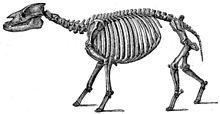
Perissodactyla is an order of ungulates. The order includes about 17 living species divided into three families: Equidae, Rhinocerotidae (rhinoceroses), and Tapiridae (tapirs). They typically have reduced the weight-bearing toes to three or one of the five original toes, though tapirs retain four toes on their front feet. The nonweight-bearing toes are either present, absent, vestigial, or positioned posteriorly. By contrast, artiodactyls bear most of their weight equally on four or two of the five toes: their third and fourth toes. Another difference between the two is that perissodactyls digest plant cellulose in their intestines, rather than in one or more stomach chambers as artiodactyls, with the exception of Suina, do.

Propalaeotherium was an early genus of perissodactyl endemic to Europe and Asia during the early Eocene. There are currently six recognised species within the genus, with P. isselanum as the type species.

Mesonychia is an extinct taxon of small- to large-sized carnivorous ungulates related to artiodactyls. Mesonychians first appeared in the early Paleocene, went into a sharp decline at the end of the Eocene, and died out entirely when the last genus, Mongolestes, became extinct in the early Oligocene. In Asia, the record of their history suggests they grew gradually larger and more predatory over time, then shifted to scavenging and bone-crushing lifestyles before the group became extinct.
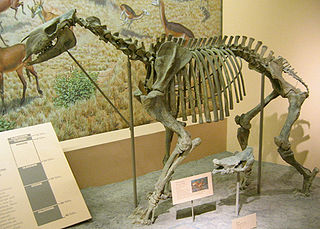
Chalicotheriidae is an extinct family of herbivorous, odd-toed ungulate (perissodactyl) mammals that lived in North America, Eurasia, and Africa from the Middle Eocene until the Early Pleistocene, existing from 48.6 to 1.806 mya. They are often called chalicotheres, a term which is also applied to the broader grouping of Chalicotherioidea. They are noted for their unusual morphology compared to other ungulates, such as their elongated clawed forelimbs. They are thought to have been browsers.
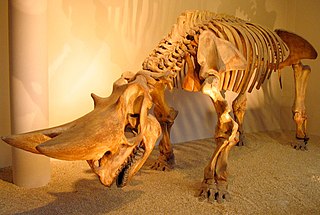
Arsinoitheriidae is a family of mammals belonging to the extinct order Embrithopoda. Remains have been found in the Middle East, Africa, Asia and Romania. When alive, they would have borne a strong but superficial resemblance to modern rhinoceroses; however, they were not closely related to them, instead being more closely related to hyraxes, elephants, sirenians, and possibly desmostylians.
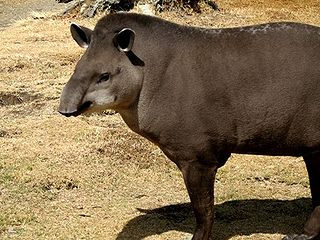
Tapiroidea is a superfamily of perissodactyls which includes the modern tapirs and their extinct relatives. Taxonomically, they are placed in suborder Ceratomorpha along with the rhino superfamily, Rhinocerotoidea.The first members of Tapiroidea appeared during the Early Eocene, 55 million years ago, and were present in North America and Asia during the Eocene. Tapiridae first appeared during the early Oligocene in Europe, and are thought to have originated from the tapiroid family Helaletidae.
Duerotherium is an extinct genus of Paleogene artiodactyls known only from the Iberian Peninsula during the Middle Eocene, which contains one species D. sudrei. It, like other members of the Anoplotheriidae, was endemic to western Europe. The anoplotheriine was described from a left fragment of a maxilla from the Mazaterón Formation of the Duero Basin in 2009. Its dentition is mostly typical of the Anoplotheriinae but differs by an elongated plus triangular 3rd upper premolar and very specific traits of the molars. It is thought to have been part of an endemic faunal assemblage that evolved within the Iberian Peninsula by the Middle Eocene, where climates were subtropical.
This paleomammalogy list records new fossil mammal taxa that were described during the year 2012, as well as notes other significant paleomammalogy discoveries and events which occurred during that year.
The Willwood Formation is a sedimentary sequence deposited during the late Paleocene to early Eocene, or Clarkforkian, Wasatchian and Bridgerian in the NALMA classification.
This paleomammalogy list records new fossil mammal taxa that were described during the year 2013, as well as notes other significant paleomammalogy discoveries and events which occurred during that year.
The Astoria Formation is a geologic formation in Washington state & Oregon. It preserves fossils dating back to the early to middle Miocene.
Cambaytherium is an extinct genus of placental mammals in the family Cambaytheriidae whose fossils were found in an open pit coal mine located in Gujarat, India. The mine was a treasure trove full of teeth and bones, over 200 of which were identified as belonging to Cambaytherium thewissi. The fossils were dated to the Early Eocene, 54.5 million years ago, making them slightly younger than the oldest known fossils belonging to the order Perissodactyla.
This paleomammalogy list records new fossil mammal taxa that were described during the year 2011, as well as notes other significant paleomammalogy discoveries and events which occurred during that year.
Isectolophidae is an extinct family of browsing, herbivorous, mammals in the order Perissodactyla. It forms a sister group to the rest of Tapiromorpha, which includes Ancylopoda and Ceratomorpha.

Sunil Bajpai is the Chair Professor of Vertebrate Paleontology in the Department of Earth Sciences, Indian Institute of Technology Roorkee. He is in service as a professor at IIT Roorkee since 1st January 1996 till September 2026. He also served as the director of the Birbal Sahni Institute of Palaeosciences from January 2013 to July 2018.
Moqueguahippus is an extinct genus of notohippid notoungulates that lived during the Late Oligocene of what is now Peru. Fossils of this genus have been found in the Moquegua Formation of Peru, which it was named after.

Dacrytherium is an extinct genus of Paleogene artiodactyls belonging to the family Anoplotheriidae. It occurred from the middle to late Eocene of western Europe and is the type genus of the subfamily Dacrytheriinae, the older of the two anoplotheriid subfamilies. Dacrytherium was first erected in 1876 by the French palaeontologist Henri Filhol, who recognized in his studies that it had dentition similar to the anoplotheriids Anoplotherium and Diplobune but differed from them by a deep preorbital fossa, where the genus name derives from. Since then, there are currently four valid species within the genus, of which D. ovinum is the type species.
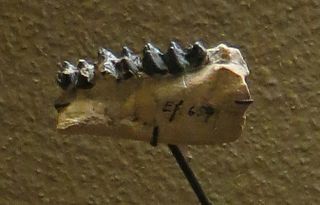
Catodontherium is an extinct genus of Paleogene artiodactyls belonging to the family Anoplotheriidae. It was endemic to Western Europe and had a temporal range exclusive to the middle Eocene, although its earliest appearance depends on whether C. argentonicum is truly a species of Catodontherium. It was first named Catodus by the French palaeontologist Charles Depéret in 1906, who created two species for the genus and later changed the genus name to Catodontherium in 1908. The Swiss palaeontologist Hans Georg Stehlin renamed one species and classified two other newly erected species to Catodontherium in 1910. Today, there are four known species, although two remain questionable in genus placement.
Ephelcomenus is an extinct genus of Paleogene artiodactyls endemic to western Europe. It contains one species E. filholi, which was first described by Richard Lydekker in 1889 but eventually classified to its own genus by the Swiss palaeontologist Johannes Hürzeler in 1938. It has an uncertain stratigraphic range, but some sources suggest that it was present in the Oligocene after the Grande Coupure turnover event of western Europe.
Robiatherium is an extinct genus of Paleogene artiodactyls containing one species R. cournovense. The genus name derives from the locality of Robiac in France where some of its fossil were described plus the Greek θήρ/therium meaning "beast" or "wild animal." It was known only from the middle Eocene and, like other anoplotheriids, was endemic to western Europe. The genus was erected by Jean Sudre in 1988 for a species originally attributed to the xiphodont genus Paraxiphodon in 1978. Robiatherium had dentitions typical of the subfamily Anoplotheriinae, differing from other genera by specific differences in the molars. It is one of the earliest-appearing anoplotheriine species in the fossil record as well as the earliest to have appeared in central Europe.
